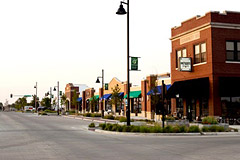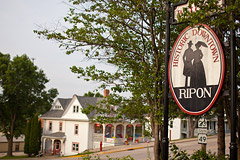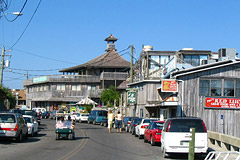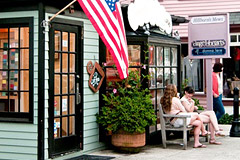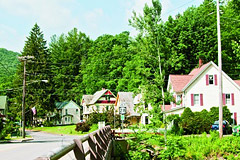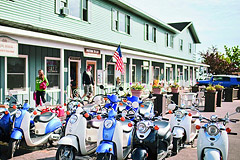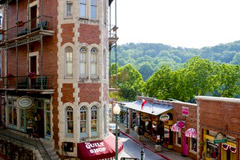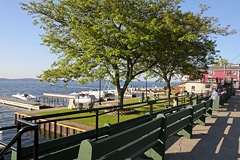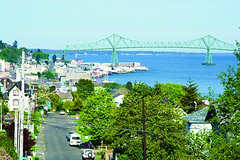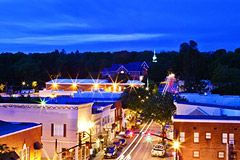健康收藏
健康为本The winners in our sixth annual celebration of great hometown escapes may be short on people, but they’re long on personality.
Once in a while, you discover a town that has everything—great coffee, food with character, shop owners with purpose. Each year, the Budget Travel team celebrates these places with our "Coolest Small Towns in America" competition. It starts with a call to you—our readers—to nominate the most interesting towns you know with populations of less than 10,000. From there, our editorial team whittles the selections down to the three most promising contenders. It's then up to you to vote on your favorite. You won't find a more charming slice of small town Americana than you will right here.
#10 Greensburg, KS (pop. 777)
The Real Emerald City
When you pull into Greensburg, you may well think you're not in Kansas anymore: Elegant wind turbines and LED streetlights have replaced cornfields and barns. After a 2007 tornado destroyed 95 percent of Greensburg, those who stayed vowed to build the ecofriendliest town ever. "These are not hippie-dippy concepts," says Stacy Barnes, director of the 5.4.7 Arts Center. "These are the same tenets used in pioneer days—south-facing windows in chicken coops to increase sunlight, reusing everything like Mennonites do. We got lazy over the past century." The gallery, named for the day the storm hit, houses contemporary art from around the U.S.
Many businesses here pay tribute to the past. Green Bean Coffee Co. serves milkshakes to fill the void left by the destruction of the old soda fountain (shakes $3.50). Nearby, you'll find innovations both high-tech (solar panels) and low (banisters made from tractor parts) at the Silo Eco-Home B&B . Just goes to show: It's not so hard being green after all.
#9 Ripon, WI (pop. 7,733)
College Town Perfection
In some college towns, the locals and students get along like rivals at the Michigan-Ohio State football game. Not in Ripon. The professors sit on the local school board. The students sing in the church choirs, and church folk welcome the school's 1,000 or so students with a potluck every fall. Friday evenings in summer, across from the college president's office in the old public library, townies and academics alike turn out for concerts on the Village Green. "My favorite is Tuba Dan's polka band," says Professor Mary Avery, who oversees a student group that helps local businesses, such as the Watson Street Sub Shop, create financial plans. Watson Street in turn lets the students use its storefront for fund-raisers.
"We are the quintessential college town," says David Joyce, president of Ripon. "Or maybe it should be the quintessential town with a college?"
#8 Cedar Key, FL (pop. 896)
Unspoiled on the Gulf
If someone asked you where to get the best New England clam chowder, you might be inclined to say, "Duh, New England." You'd be wrong—by over 1,000 miles. For the past three years, the Great Chowder Cook-Off in Newport, R.I., has been won by Tony's Seafood Restaurant of Cedar Key. In fact, the town is America's second-largest producer of farmed clams, one of many surprises in this two-square-mile hamlet 130 miles north of Tampa. Despite its prime location on the Gulf of Mexico, Cedar Key has escaped the pull of developers-its spit of beach isn't long enough to attract large-scale building projects. Instead, it still feels like a ramshackle, old fishing village straight out of Hemingway.
"People always say it's like Key West 30 years ago," says innkeeper Ada Lang. Built in 1919 and restored in 2004, Ada's Wabi Sabi Cottage is a time-capsule example of a "Cracker" cottage, a style of wood-frame house popular in the 19th century.
#7 Newtown Borough, PA (pop. 2,384)
Amish Country Charm
Newtown Borough isn't the kind of place where you'd expect to see millionaires tooling around in a fancy car. In fact, the rural Bucks County burg is close enough to Amish Country that most of the convertibles around these parts are horses-and-buggies.
It's home to the nation's oldest movie theater, Newtown Theatre, a 375-seat, red-brick treasure that's been in operation since 1906. The Brick Hotel, built in 1764 and still looking sharp decked out in hunter green shutters and striped awnings, is one of the few places that can honestly claim that George Washington slept here. And director M. Night Shyamalan likes the look of Newtown so much, he filmed Signs here in 2002.
#6 Phoenicia, NY (pop. 309)
A Riverside Retreat
Phoenicia may look like a one-street river town sandwiched between hills in New York's Catskills—it does a wicked tubing business in the summer—but it's got a bookish, cosmopolitan vibe in its soul. "It's not just crazy guys with cars in their yards," says Michael Koegel of Mama's Boy, a hip little cafe and smoothie bar. Like Koegel, many Phoenicians came from Manhattan, and they've brought a healthy dose of quirk with them. For instance, former New Yorker Alan Fliegel, sells locally made clothing and underground comic books—and runs a well-stocked communal art gallery upstairs.
Yet like its library that loans fishing poles, Phoenicia hasn't lost touch with its down-home roots. If you spend the night at the cozy Phoenicia Lodge, you may feel like you've woken up in Mayberry. You certainly will after breakfast at Sweet Sue's Restaurant . The pancakes (pumpkin, pineapple-coconut, and 20-plus other varieties) are legendary, as are the lines waiting to get inside.
#5 La Pointe, WI (pop. 309)
A Superior Hamlet
It's called the Island Wave, and to the folks on Madeline Island—a quiet, North Woods enclave of artists on Lake Superior—it means you greet everyone, even when you're driving. It's a lovely idea, but in summer it can get, well, dangerous. That's when La Pointe, the island's only town, swells with visitors. "The line goes out the door for hours on July 4th," says Marie Noha, owner of the Mission Hill Coffee House.
#4 Eureka Springs, AR (pop 2,073)
Honeymoons and More
Sure, you could sleep in one of the Queen Anne-style B&Bs, visit the monumental 67-foot-tall hilltop Christ of the Ozarks, catch a Branson-style show, or hunt for ghosts in the historic downtown. You could easily spend a week on the tourist circuit in this late-1800s Victorian spa retreat. But you'd never get to meet the real Eureka Springs.
Eureka Springs may be the honeymoon capital of the Ozarks, but don't let the kitschy, heart-shaped Jacuzzis fool you. The biggest surprise of all may be the 1886 Crescent Hotel and Spa, a palatial ivy-covered grand hotel with claw-foot tubs and manicured gardens. From this perch, you'll be inclined to look back to see Eureka Springs, but the leafy Ozarks keep the valley all but hidden from view—an apt vista for a town dubbed Tree City USA.
#3 Clayton, NY (pop. 1,978)
A River Runs to It
Clayton sits on a peninsula that juts out into the St. Lawrence River, so far north that the fire department's boat flies the American and Canadian flags. One of the benefits of that isolation is that the river itself is like a neighbor. In the summer, the old ferry terminal, where wealthy visitors once caught rides to their cottages on the Thousand Islands (birthplace of Thousand Island salad dressing), now hosts concerts. Out on the water, the family-run Ferguson Fishing Charters offers morning fishing trips followed by picnics on a private island, where a guide cooks the day's catch over a fire for lunch (half-day charters for a group of four $325).
Back on dry land, K's Motel & Cottages' two-night "ship watch special" includes a room, a two-and-a-half-hour boat cruise, admission to the Antique Boat Museum, and two meals.
#2 Astoria, OR (pop. 9,477)
Pioneers on the Pacific
Astoria has always been on the frontier, both the Lewis and Clark variety (they set up camp here in 1805) and the geographic (it sits both at the mouth of the Columbia River and in a teeming temperate rain forest). Sure, the place has prettied itself up nicely since those pioneer days with the addition of aging Victorians and craftsman-style bungalows, but the folks in sleepy coastal Astoria have never lost touch with their rough-and-tumble side.
Even the city's swankiest design hotel, the Commodore, embraces a decidedly masculine and nautical aesthetic. Reopened two years ago after being shuttered since 1966, the property pairs modern furnishings with sly nods to the city's history as a seaside cannery hub: thick braided ropes, nautical charts, and fishing floats.
#1 Lewisburg, WV (pop. 3,830)
Arts in Appalachia
A small town is usually lucky if there's a decent one-screen movie theater, maybe a community dance troupe. But a Carnegie Hall? This speck on the map in the Greenbrier River Valley lays claim to one of only four in the world. The 1902 building now serves as Lewisburg's creative control tower, attracting an unlikely band of artistic characters, back-to-the-land types, and retirees.
Jeanne and Michael Christie embody Lewisburg's blend. The duo run the Davenport House B&B, where guests can bottle-feed one of the property's baby lambs after taking coffee and breakfast on their private patio. Michael is a painter whose work has shown in New York City's Hoorn-Ashby gallery, and Jeanne is the former director of front-office operations at the Greenbrier hotel, 10 miles down the road.
"You know, you always think of the ideal American town, where the kids are safe, the streets are clean. We have that, but we also have Wynton Marsalis coming through," says Jeanne, who'd just finished a morning of shearing sheep.




